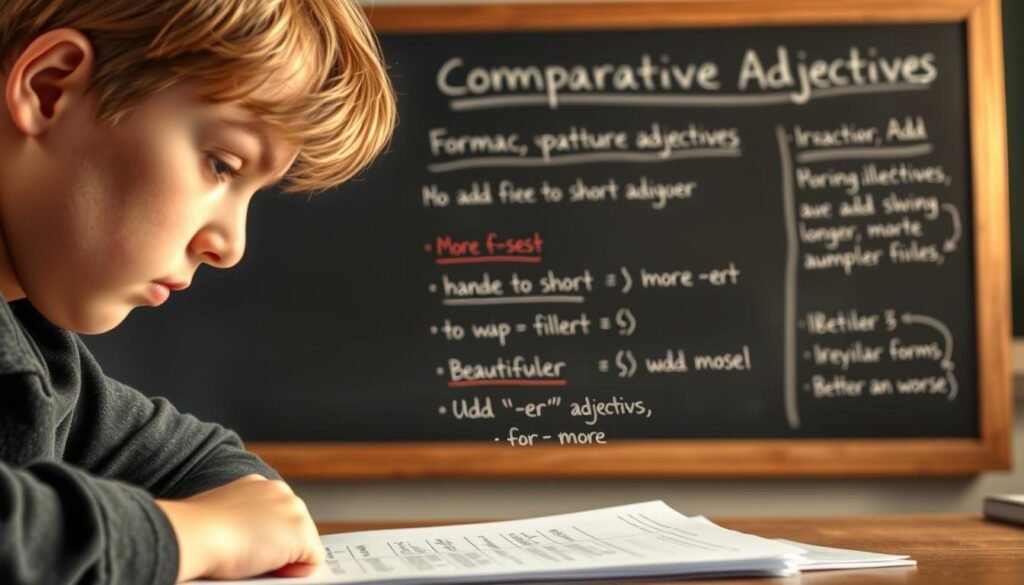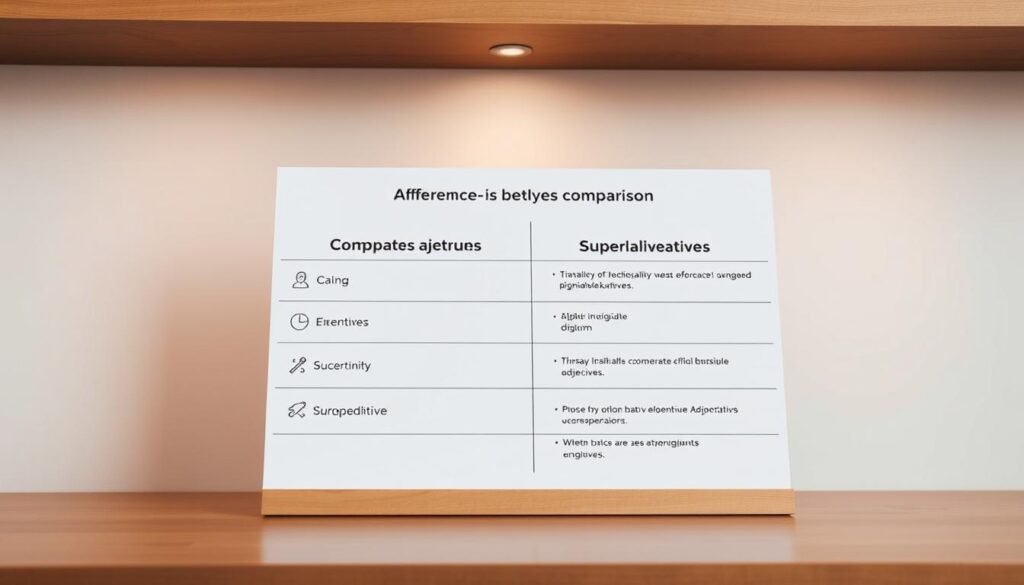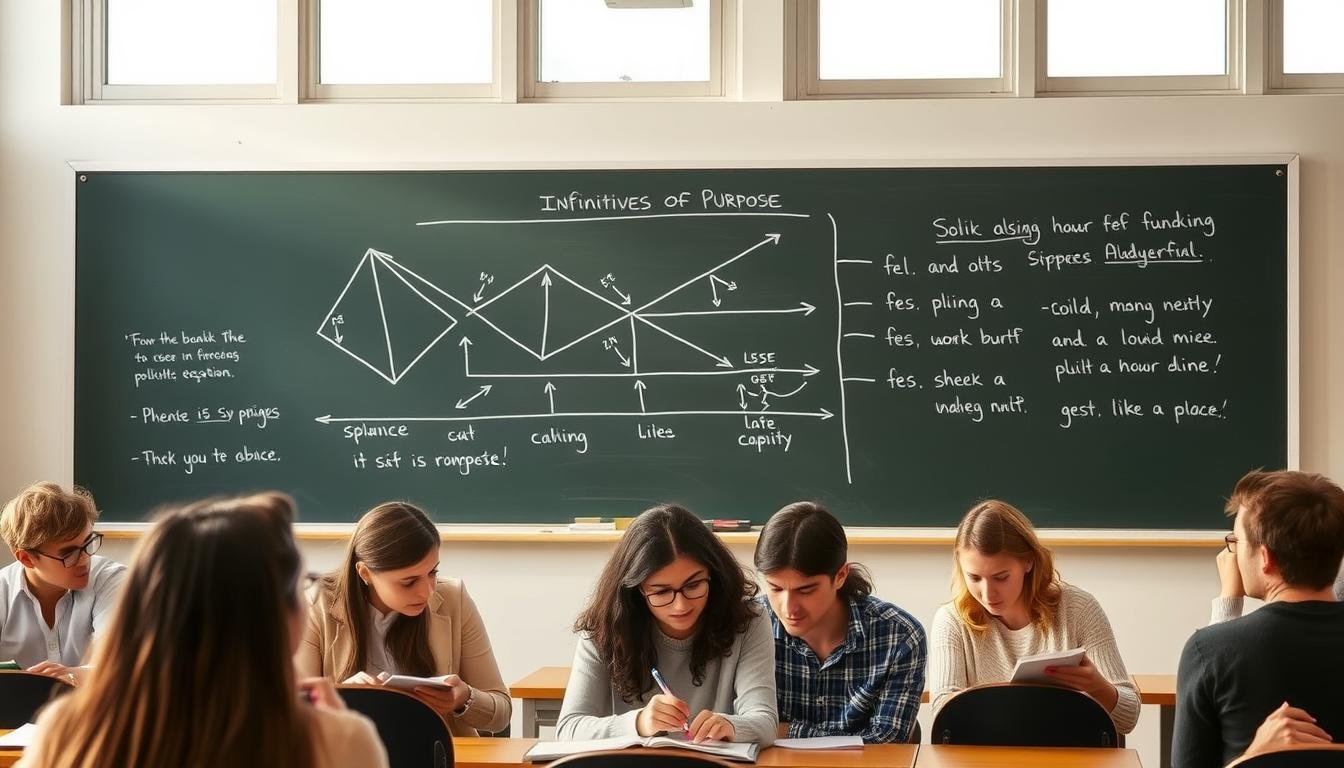Now Reading: Learn Comparative Adjectives for Better English
-
01
Learn Comparative Adjectives for Better English
Learn Comparative Adjectives for Better English

Learn Comparative Adjectives for Better English
Ever wonder how a simple word like “better” can make a big difference? Comparative adjectives are the secret to showing differences clearly. They help us talk about skills, ideas, and daily life more effectively.
Words like “faster,” “smarter,” or “more creative” make it easy to show contrasts. But, many people get confused between “gooder” and “better.” This article will show you how to use comparative adjectives right. It will help you speak and write with more confidence and clarity.

Key Takeaways
- Comparative adjectives highlight differences between two items
- Correct structures like “more interesting” vs. “interestinger” matter
- Mistakes in adjective comparison weaken professional and casual communication
- Rules apply differently for short vs. longer adjectives
- Mastery improves persuasive speaking and writing skills
Understanding Comparative Adjectives in English
Comparative adjectives show how two things differ by highlighting more or less of a quality. They are key for clear talk in everyday life, school, and work. Let’s dive into what they are and why they matter.
What Are Comparative Adjectives?
Comparative adjectives change nouns to show differences. For example, “faster” talks about speed, and “quieter” is about noise. They focus on the differences:
| Adjective | Comparative Form | Example |
|---|---|---|
| Smart | Smarter | She is smarter than him. |
| Happy | More happy | They felt more happy after the news. |
Why Comparatives Matter in Communication
“Comparative adjectives turn vague statements into clear contrasts, enhancing understanding and engagement.”
- Clarify differences without ambiguity
- Enhance persuasive writing by emphasizing strengths (e.g., “cheaper options”)
- Facilitate comparisons in reviews, debates, and reports
The Basic Structure of Comparisons
Most sentences have a pattern: X + be verb + comparative form + than + Y. For example: “This laptop is lighter than that one.” There are exceptions, like “as + adjective + as” for equality.
Knowing this structure helps avoid confusion. It makes sure messages are clear. Practice spotting comparative forms to get better at talking and writing.
The Rules of Forming Comparative Adjectives
Learning about comparative form adjectives has clear rules. Follow these steps to make comparisons right and avoid mistakes.
Short Adjectives: The -er Rule
Add -er to short adjectives with one or two syllables:
- tall becomes taller
- fast becomes faster
- loud becomes louder
Long Adjectives: Using “More”
For long adjectives with three or more syllables, add more before them:
- beautiful → more beautiful
- complicated → more complicated
These comparative adjectives rules help keep sentences correct.
Special Spelling Rules to Remember
Keep in mind these special rules for forming comparatives:
| Rule | Example | Correct Form |
|---|---|---|
| Double final consonant | big → biger | bigger |
| Drop silent ‘e’ | nice → niceer | nicer |
| Change ‘y’ to ‘i’ | happy → happyer | happier |
These rules help avoid common errors in using comparative adjectives rules.
Irregular Comparative Adjectives You Must Know
Learning English comparisons means knowing special list of comparative adjectives. These don’t follow the usual “-er” or “more” rule. Yet, they are key for clear communication.
- Good → Better (e.g., “This pizza tastes better.”)
- Bad → Worse (e.g., “The weather is worse today.”)
- Far → Farther/Further (e.g., “She walked farther than yesterday.”)
- Old → Elder/Older (e.g., “My elder sister is older than me.”)
| Adjective | Comparative Form | Example Sentence |
|---|---|---|
| Little | Less | “Use less sugar next time.” |
| Many/Much | More | “We have more books than you.” |
| Bad | Worse | “This plan is worse than the first idea.” |
“Farther” is for physical distance, while “further” is for abstract ideas. Using them wrong can confuse people. “Elder” is for family age, and “older” is more general. Knowing these differences is important for better writing and speaking.
Practicing with examples of comparative adjectives helps you get better. It makes your English more accurate and smooth.
Using “Than” in Comparative Sentences
Knowing where to put “than” is crucial for clear comparative adjectives. This word connects two parts in every comparison. Without it, sentences like “She runs faster” don’t make sense.
The Structure of Comparative Sentences
Every comparison has a specific structure: Subject + comparative adjective + than + noun/pronoun. For example: “This laptop is cheaper than mine.” Here, “than” links the two items. But, if you say “Cheaper than mine is this laptop,” it messes up the meaning.
Common Mistakes When Using “Than”
- Confusing “than” with “then”: “He is taller then his sister” is wrong.
- Pronoun errors: “He is older than me” is okay in casual talk, but “older than I” is more formal.
- Incomplete comparisons: Phrases like “This car is faster than…” need to say what it’s being compared to.
Comparing Nouns vs. Comparing Actions
When comparing nouns, look at qualities: “Coffee is stronger than tea.” For actions, verbs come first: “She swims faster than she runs.” Make sure the elements being compared match up.
Advanced Uses of Comparative Adjectives
Learning about comparative adjectives can make your English more precise. They help you express complex ideas clearly.
“The harder you work, the faster you learn.” This sentence uses comparative adjectives to show cause and effect. It’s a common way to write in school and share motivational messages.
Idiomatic expressions often use comparative adjectives. Phrases like “better late than never” or “easier said than done” add depth to language. They make ideas stick in our minds by comparing them in unique ways.
When talking about proportions, you need to use the right words:
- Use as…as for equality: “She runs as fast as her coach.”
- Pair “the + comparative” to show proportion: “The louder the music, the fewer people stay.”
| Modifier | Example |
|---|---|
| Much | “This project is much more challenging.” |
| Slightly | “Her answer was slightly incorrect.” |
| Far | “This method is far simpler.” |
In formal writing, stay away from casual words like “way.” Use clear language instead. These tips can take your writing from simple to advanced. Keep practicing to get better!
Common Mistakes When Using Comparative Adjectives
Learning comparative adjectives rules means avoiding common mistakes. Even those who are good at it can still get it wrong. Let’s look at three common errors to improve your adjective comparison skills.

Double Comparatives to Avoid
Using too many intensifiers can make your sentences unclear. Phrases like “more better” or “more faster” are wrong. Always pick one form:
- Incorrect: “This phone is more faster.”
- Correct: “This phone is faster.”
Mixing Short and Long Forms
Two-syllable adjectives can be tricky. Use “more” for most words with more than one syllable. But some follow the -er rule:
- Incorrect: “She’s more happy than him.”
- Correct: “She’s happier than him.”
Incorrect Use with Absolute Adjectives
Some adjectives describe extremes and can’t be compared. Words like unique, entire, or perfect can’t become comparative:
- Incorrect: “That painting is more unique.”
- Correct: “That painting is unique.”
By reviewing these mistakes, you can make your comparisons sound natural. Try rewriting sentences like: “This car is faster than that one” instead of “more faster”. Following comparative adjectives rules helps you communicate clearly.
Practical Exercises to Master Comparative Adjectives
Boost your skills with comparative adjectives exercises. This part has structured activities and a downloadable comparative adjectives worksheet. The worksheet has challenges that get harder as you go along. Each task helps you use comparative forms with confidence in real-life situations.
Fill-in-the-Blank Practice
Test your knowledge with sentences like:
- This car is faster than that one.
- Math is more difficult than English.
- Her voice is quieter than his.
Sentence Construction Drills
Build sentences using prompts such as:
- Compare the speed of two animals using “more.”
- Use “-er” forms to contrast two sports.
- Describe weather differences with “less.”
Real-World Application Scenarios
Apply skills to everyday situations:
- Shopping: “This laptop is cheaper than the brand model.”
- Travel: “Paris is busier than this town.”
- Interviews: “I’m more experienced in marketing than my colleague.”
Each exercise includes answer keys for self-checking. Download the comparative adjectives worksheet for more practice. The key to mastering is repetition—try each task every day to improve your skills!
Comparative vs. Superlative: Understanding the Difference

Comparative and superlative adjectives have different jobs in English. Comparative adjectives show differences between two things. Superlatives find the best among three or more.
For instance, “smarter” compares two people. But “smartest” picks the top one in a group.
| Adjective | Comparative | Superlative |
|---|---|---|
| Fast | faster | fastest |
| Happy | happier | happiest |
| Difficult | more difficult | most difficult |
How you make them changes. Short adjectives get “-er” (like big → bigger). Superlatives get “-est” (like big → biggest).
Adjectives with three or more syllables use “more” and “most” (like important → more important → most important). Some, like good → better → best, are irregular.
- Comparative: “She runs faster than him.”
- Superlative: “She is the fastest runner in the team.”
Using them wrong can confuse people. A list of comparative adjectives helps find patterns. Always think: Are we comparing two or more things? This decides which form to use.
Conclusion: Enhancing Your English Through Effective Comparisons
Learning comparative adjectives helps you describe differences well. They are useful for talking about sizes, qualities, or experiences. By practicing, you’ll get better at using them in everyday talk and writing.
Start with exercises and worksheets to improve. Each one helps you understand the difference between “more beautiful” and “beautifuller.” It also teaches you to avoid mistakes like “more better.”
Using them in real life is key. Think about why one job is better than another or when choosing travel plans. These situations happen every day, so practicing is crucial.
Make sure to review tricky words like “worse” and “worst.” Also, practice using “than” correctly in sentences. Doing this often will make you more accurate. English gets easier when you use these skills a lot.
Keep working on your skills. The more you practice, the clearer and more confident you’ll become in speaking and writing.
FAQ
Q: What are comparative adjectives?
A: Comparative adjectives compare two things. They show which one has more or less of something. Words like “taller,” “smarter,” and “more interesting” help us see differences.
Q: How do I form comparative adjectives?
A: To make comparative adjectives, add “-er” to short words. For example, “fast” becomes “faster.” For longer words, use “more” before the word, like “beautiful” becomes “more beautiful.”
Q: What are some examples of irregular comparative adjectives?
A: Some adjectives don’t follow the usual rules. “Good” becomes “better,” “bad” becomes “worse,” and “far” can be “farther” or “further.” You need to remember these as exceptions.
Q: When should I use “than” in comparative sentences?
A: Use “than” to link the comparison in sentences. For example, “She is taller than her sister” uses “than” to show the comparison.
Q: What are some common mistakes to avoid when using comparative adjectives?
A: Avoid mistakes like “more better” or mixing up short and long adjectives. Also, don’t use comparative forms with absolute adjectives like “unique.”
Q: How can I practice using comparative adjectives effectively?
A: Practice with fill-in-the-blank exercises, sentence building, and real-life examples. These help you remember the rules and use them correctly.
Q: Can comparative adjectives be used in formal writing?
A: Yes, they are used in formal writing to be clear and precise. They help in essays, reports, and academic papers to show differences.
Q: How do comparative adjectives differ from superlative adjectives?
A: Comparative adjectives compare two things. Superlative adjectives show the highest among three or more. For example, “Mary is taller than Jane” is comparative, while “Mary is the tallest in the class” is superlative.






























